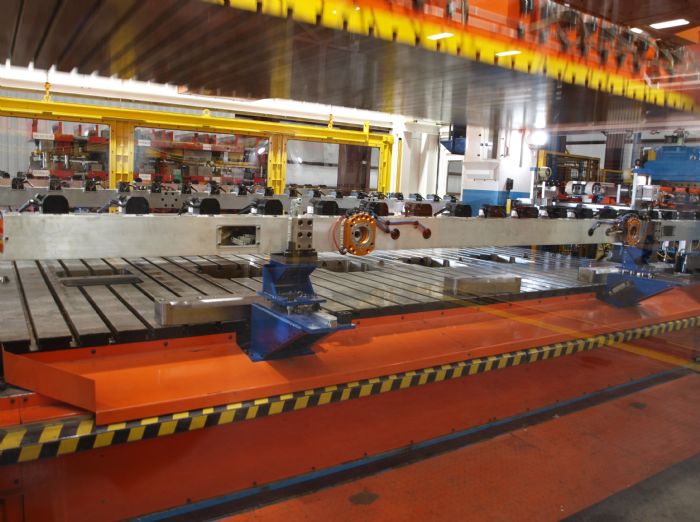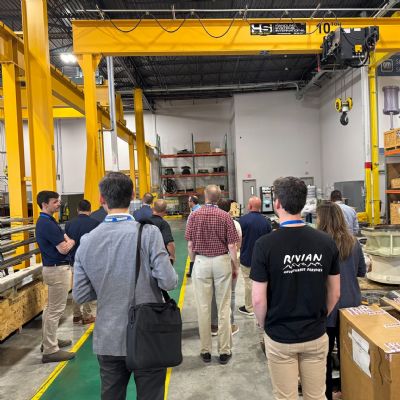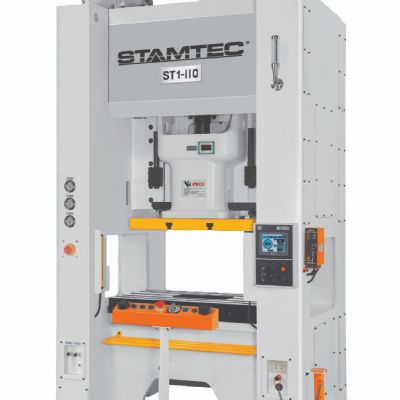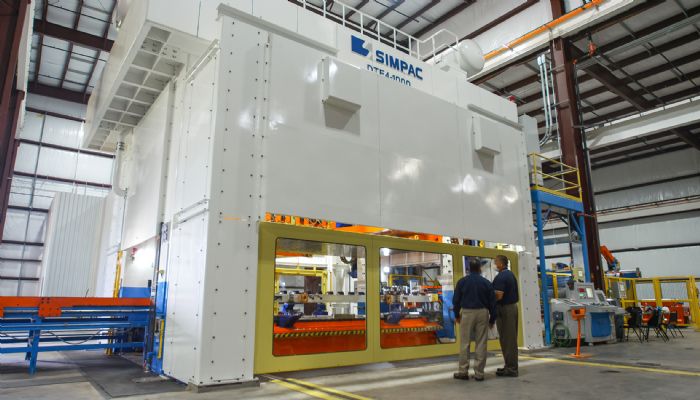 Gardner brought to Martinrea a diverse background, having worked as an assembly-plant manager at an automotive lighting supplier; director of operations at Hamilton Sundstrand; and in a variety of management positions at automotive OEMs Nissan Motor Corp., Toyota Motor Manufacturing Kentucky and General Motors. I asked him how his experience with the automotive OEMs contributes to his ability to serve and react to the changing needs of who are now his OEM customers.
Gardner brought to Martinrea a diverse background, having worked as an assembly-plant manager at an automotive lighting supplier; director of operations at Hamilton Sundstrand; and in a variety of management positions at automotive OEMs Nissan Motor Corp., Toyota Motor Manufacturing Kentucky and General Motors. I asked him how his experience with the automotive OEMs contributes to his ability to serve and react to the changing needs of who are now his OEM customers.
“In this current environment, flexibility is critical to enable us to adapt and quickly respond to customer needs so that we continue to supply our customers on time with good parts,” Gardner says. “We must be weeks ahead of the OEMs in our changepoint management, meaning that at lower volumes we focus on our direct and indirect labor models, and understand headcount and parts/hr. output that allow us to absorb that headcount but maintain the required efficiencies. We also look at the indirect-labor models and the PM (preventive maintenance) activities required to keep our presses and welding cells running—based on run-time hours rather than calendar days. And we must look at materials on order—understand the outlook, look a quarter ahead to see what changes are coming, and give our purchasing department and production managers time to either slow down or request more material from our suppliers.
“Finally,” Gardner adds, “from the method side, we must have a good, clear focus on how to train and cross-train people, and ensure that if we move people to different areas that we have a method to move them and partner them with a peer.”
When Gardner started with the facility in July 2018, its pressroom was managing about 80 stamping dies and feeding parts to 35 welding cells; direct-labor headcount hovered around 150. Now, with projects for four new OEMs on their way into production, the pressroom is managing the work of more than 280 tools; 75 welding cells now will assemble stamped parts; and direct-labor headcount will peak at more than 200 team members.
“Cross training (see the accompanying sidebar) keeps us flexible with respect to unforeseen issues such as absenteeism,” Gardner says. “For example, we have primary-process operators and secondary-process operators—the key is to train each team member on at least three processes, ensure that each process is understood by at least three team members, and have at least three team members able to run every process. All the while, we must ensure that the people that are the closest to our customers remain effective and able to produce quality parts in the time required.”
A Right-Sized Press
On the equipment side of the rapid increase in work expected to run through this facility is a new 1000-ton eccentric-drive mechanical transfer press, which arrived early in 2020. The Simpac DTE4-1000 press boasts a 220 by 84-in. bed, 52-in. shut height and dual rolling bolsters. It’s outfitted with a Linear Transfer servo transfer system with 60 in. of pitch, 30 in. of clamp motion per side and 52 in. of lift, with a 300-lb. payload capacity. The system quickly and easily parks up and out of the way to transition the press over to progressive-die work using a standard coil line with micro feeder (from Korean manufacturer Daebong). Die lubrication comes via a Unist SPR-2000 programmable fluid controller governing fluid flow to low-volume spray nozzles. An Allen Bradley control oversees all press-cell functions, including a Helm tonnage monitor and a maximum of 32 die-protection inputs.
The press, housed in a new 30,000-sq.-ft. addition large enough to also store dozens of dies, joins nine other presses in the facility, including three large models (two 1500-ton presses and a 1700-ton press). The additional press capacity, in concert with nearly doubling its number of welding cells to assemble stamped parts, “allows our customers—the OEMs—to send us more work and free up their own floorspace,” Gardner says. “Of course, that only happens if they trust that we can produce quality parts and assemblies, using reliable and flexible equipment.”
That’s where the new Simpac press really shines, and Gardner expects its flexibility—due to the large bed size, transfer system and dual rolling bolsters—to enable the facility to absorb so much new work. Its large press bed, he notes, larger than a typical 1000-ton press, will allow the production team to optimize productivity by taking on lower-tonnage jobs (1000 tons and less) that need the bigger bed size—jobs that now run on the facility’s 1500- and 1700-ton presses.
“Moving those jobs to the Simpac press, which runs at a higher stroke rate than the bigger presses,” Gardner says, “will then free up time on the higher-tonnage presses. We run all of our presses at 80-percent capacity or more, and the new press will take on work requiring up to 800 tons.
Along with bringing in a host of new stamping and welding equipment to nearly triple production capacity at the Martinrea facility in Springfield, TN, the plant’s general manager Esau Gardner has been keenly focused on building and training an efficient, cross-trained workforce. “We use the Harvey Ball process to track our operator-training progress,” he shares. “When we identify a person to be trained, we represent that person in the Harvey Ball ideogram as a circle with nothing in it—they’re at the orientation level. At the quarter-pie level, we introduce an operator to his team and teach him all of the safety aspects of the job. At half-pie, the operator understands not only the safety protocols but also the job instructions, and he’s allowed to run jobs in increments of time. For example, if the workcell produces 60 parts/hr., the trainee must watch the trainer and the trainer will let the trainee produce maybe four parts, then let the trainee go back to observing. Then perhaps the trainee can run the cell for 15 min. at a time, etc.… We keep increasing their incremental time running the cell until we feel that trainees are ready to run the process on their own.” The process provides feedback and allows for repetition training. “When the trainee is ready to run in takt time, or the required cycle time and with no defects,” Gardner continues, “we then sign off at the team-leader and supervisor level. Once people are here for 30 days and they’re able to run the process without defects, and if they have initiative and drive and want to do more, we then send them to the train-the-trainer class. Here they learn to understand what a good process looks like, ergonomically and without variability and waste. “Those are the three things,” Gardner stresses, “that prevent operators from being able to truly focus on building good parts—ergonomics, process variation and waste. We want secure and safe operators that understand the processes and who work efficiently without generating excess waste.”
“Knowing where the automotive industry is going,” Gardner continues, “with the continued move to lighter structures, the press tonnage required can be reduced for many tools. That’s primarily what motivated us to look for a lower-tonnage but correctly sized press that would give us a high stroke rate, and, therefore, put us in a good position for capacity and availability. The 1000-ton Simpac is the perfect match; we right-sized the press based on what we needed.”
Target Dates, Milestones and KPIs
Gardner also emphasizes the importance of adhering to a strict and tight timeline, from press order to installation to commissioning, based on guidelines set forth by the plant’s OEM customers. “We needed Simpac to hit all of its target dates and major milestones,” he stresses, “and it did—from buyoff to loading it onto the ship, to installing and commissioning.”
The press, installed in May 2020, is equipped to stamp aluminum and steel, thanks to a conveyor system with two diverters to enable scrap segregation. “Once we change dies or move from steel to aluminum, we implement a cleaning procedure and then switch the diverter,” Gardner shares.
One critical key-performance indicator Gardner and his management team have their eyes on: quick changeovers. Of the 200 new tools on the way, some 40 of them will run regularly on the Simpac press.
“We’ve typically been changing over our presses an average of once per day, per press,” he says. “However, with these new tools coming in and the programs they’re on, we expect to double that changeover frequency. And, the new Simpac press will experience even more changeovers, as we look to take advantage of its dual bolsters and other quick-die-change (QDC) technology, including the ability to quickly change transfer bars and the use of hydraulic die clamping. That press, once fully loaded, will probably experience four to five die changes per day.”
With more-frequent die changes coming, the plant’s lean team has been hard at work whittling down die-change times. With an internal goal of 30-min. changes on the larger presses, Gardner says the target for the new 1000-ton press is 15-20 min.
“Our lean team has implemented several quick-die-change initiatives,” he says, “including development of a pre-flight checklist for every changeover. We’re focused on getting as much of the work needed to prepare for a changeover performed while the press runs—preparing a QDC cart, staging the next die, etc. Quicker changeovers enhance process flexibility and drives press productivity to new heights.” MF
View Glossary of Metalforming Terms
See also: SIMPAC America Co. Ltd., Martinrea International
Technologies: Stamping Presses
Comments
Must be logged in to post a comment. Sign in or Create an Account
There are no comments posted. Stamping Presses
Stamping PressesFagor Arrasate Begins Expansion of Its Mondragón, Spain Plan...
Friday, July 11, 2025
Fontaine Spray Suppression Increases Production with Help of...
Tuesday, June 24, 2025
 Stamping Presses
Stamping PressesAndritz Schuler Workshop Highlights Service and Product Capa...
Friday, June 20, 2025
 Stamping Presses
Stamping PressesPrecision and High-Speed Mechanical Presses
Wednesday, June 18, 2025







 However, when it comes to its bread-and-butter automotive market, Martinrea excels at providing an extensive lightweighting portfolio that includes chassis components and assemblies, body-in-white parts, sub-frame systems and even battery trays.
However, when it comes to its bread-and-butter automotive market, Martinrea excels at providing an extensive lightweighting portfolio that includes chassis components and assemblies, body-in-white parts, sub-frame systems and even battery trays.